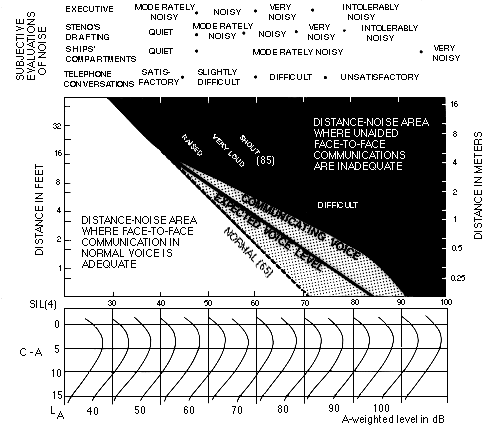A measure of the degree to which background noise interferes with or MASKs speech. It is obtained by averaging the SOUND PRESSURE LEVELs in the octave frequency bands centred on 500, 1000, 2000 and 4000 Hz, or by taking the A-weighted SOUND LEVEL (see SOUND LEVEL METER).
The spectrum of speech sound, however, is distributed over a wide range of 100 to 10,000 Hz, with the range from 200 to 6000 Hz being critical for full intelligibility. HEARING LOSS with age (PRESBYCUSIS) or noise-exposure (see THRESHOLD SHIFT) can also interfere with speech communication.
See also: REVERBERATION, SPEECH COMMUNICATION CRITERION, TRANSIENT. Compare: NOISE CRITERION, NOISE RATING, SOUND TRANSMISSION CLASS.
However, in the situation with face-to-face conversation of non-familiar speech material, the following chart shows the speech interference level of background noise for men with average voice strengths. At levels above 50 dBA, people raise their voice level as shown by the "expected" line if communication is not vital, or by the "communicating" line if it is. In the lower left hand area, normal voice levels are possible with an ARTICULATION INDEX of 0.5 and 98% sentence intelligibility; the area of the upper right hand corner denotes situations where unaided voice communication is impossible.
For telephone conversations, the following ranges apply: 60 dB or less as satisfactory, 60-75 dB as making telephone use difficult, and over 75 dB as unsatisfactory.

Necessary voice levels as limited by ambient noise for selected distances between speaker and listener for satisfactory face-to-face communication (from J.C. Webster, "Speech Interference by Noise," Proceedings, Inter-Noise 74, Institute of Noise Control Engineering, p. 558, used by permission of the author).
home